 Season’s Beatings #1 (of 1) — Writer: Jason Latour; Art/Colors:Various
Season’s Beatings #1 (of 1) — Writer: Jason Latour; Art/Colors:Various
Defenders: The Best Defense #1 — Writer: Al Ewing; Pencils: Joe Bennett; Inks: Belardino Brabo; Colors: Dono Sanchez-Almara
True Believers: Fantastic Four — Frightful Four #1 (of 1) — Writer: Stan Lee; Pencils: Jack Kirby; Inks: Chic Stone
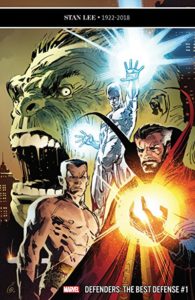 True Believers: Fantastic Four — Klaw #1 (of 1) — Writer: Stan Lee; Pencils: Jack Kirby; Inks: Joe Sinnott
True Believers: Fantastic Four — Klaw #1 (of 1) — Writer: Stan Lee; Pencils: Jack Kirby; Inks: Joe Sinnott
True Believers: Fantastic Four — Blastaar #1 (of 1) — Writer: Stan Lee; Pencils: Jack Kirby; Inks: Joe Sinnott
True Believers: Fantastic Four — Ronan #1 (of 1) — Writer: Stan Lee; Pencils: Jack Kirby; Inks: Joe Sinnott
 Season’s Beatings is a Deadpool holiday anthology — Wade has a typically fourth-wall-breaking wraparound plot that incorporates Christmas tales including: a Peter Parker/Miles Morales Spider-Man story drawn by Chris Brunner; a Squirrel Girl/Doctor Doom one by Mario del Pennino; and a West Coast Avengers by Veronica Fish. Jason Latour, who writes the whole thing, does a good job of threading continuity
Season’s Beatings is a Deadpool holiday anthology — Wade has a typically fourth-wall-breaking wraparound plot that incorporates Christmas tales including: a Peter Parker/Miles Morales Spider-Man story drawn by Chris Brunner; a Squirrel Girl/Doctor Doom one by Mario del Pennino; and a West Coast Avengers by Veronica Fish. Jason Latour, who writes the whole thing, does a good job of threading continuity  and funny bits between all those moving parts, and getting everyone’s voices right, and if you like Deadpool and/or the group of relatively-new kids featured here, this will be worth your time. Defenders #1 resurrects that long-lived title team; instead of using the Netflix urban-avenger lineup, though, it reverts to the classic heavy-hitter cast of Doctor
and funny bits between all those moving parts, and getting everyone’s voices right, and if you like Deadpool and/or the group of relatively-new kids featured here, this will be worth your time. Defenders #1 resurrects that long-lived title team; instead of using the Netflix urban-avenger lineup, though, it reverts to the classic heavy-hitter cast of Doctor 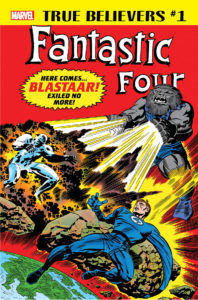 Strange, Silver Surfer, Sub-Mariner and the Hulk. Al Ewing, who’s been killing it over in the regular Immortal Hulk comic, writes a smart script that combines a sprawling cosmic-level menace with keen-eyed takes on each of the main characters, and if you like high-energy, lots-of-punching superhero comics with brains, this one’s pretty good. The
Strange, Silver Surfer, Sub-Mariner and the Hulk. Al Ewing, who’s been killing it over in the regular Immortal Hulk comic, writes a smart script that combines a sprawling cosmic-level menace with keen-eyed takes on each of the main characters, and if you like high-energy, lots-of-punching superhero comics with brains, this one’s pretty good. The 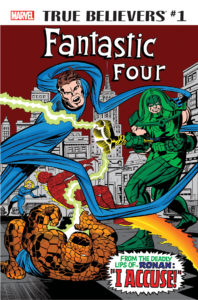 Fantastic Four $1 “True Believer” reprints continue, with four this week, all highlighting bad guys: the first appearance of the Frightful Four, from FF #36; of the villainous Klaw (and, not incidentally, the second part of the introduction of the Black Panther), from #52; the Negative-Zone despot Blastaar, from #62 (and sporting a double-page Kirby photo-collage of the Zone itself); and the Kree Ronan the Accuser, from #65. This is prime Lee/Kirby work, the beating heart of the ’60s Marvel universe, and if you’ve never read them 80 pages’ worth for $4 qualifies as a Christmas miracle.
Fantastic Four $1 “True Believer” reprints continue, with four this week, all highlighting bad guys: the first appearance of the Frightful Four, from FF #36; of the villainous Klaw (and, not incidentally, the second part of the introduction of the Black Panther), from #52; the Negative-Zone despot Blastaar, from #62 (and sporting a double-page Kirby photo-collage of the Zone itself); and the Kree Ronan the Accuser, from #65. This is prime Lee/Kirby work, the beating heart of the ’60s Marvel universe, and if you’ve never read them 80 pages’ worth for $4 qualifies as a Christmas miracle.
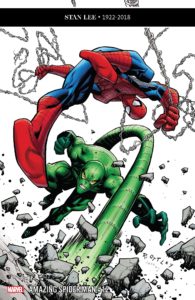 Amazing Spider-Man #12 (Legacy #813 ) — Writer: Nick Spencer; Pencils: Ryan Ottley; Inks: Cliff Rathburn; Colors: Laura Martin
Amazing Spider-Man #12 (Legacy #813 ) — Writer: Nick Spencer; Pencils: Ryan Ottley; Inks: Cliff Rathburn; Colors: Laura Martin
Spider-Geddon #5 (of 5) — Writer: Christos Gage; Pencils: Jorge Molina, Carlo Barberi, Stefano Caselli and Joey Vazquez; Inks: Jay Leisten, Jose Marzan Jr., Stefano Caselli and Joey Vazquez; Colors: David Curiel
Uncanny X-Men #6 (Legacy #625) — Writers: Matthew Rosenberg, Kelly Thompson and Ed Brisson; Art: Yildiray Cinar; Colors: Rachelle Rosenberg
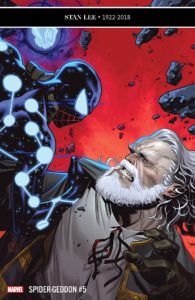 Extermination #5 (of 5) — Writer: Ed Brisson; Art: Pepe Larraz; Colors: Marte Gracia
Extermination #5 (of 5) — Writer: Ed Brisson; Art: Pepe Larraz; Colors: Marte Gracia
Domino #9 — Writer: Gail Simone; Pencils: David Baldeon and Michael Shelfer; Ink Assist: Roberto Poggi; Colors: Guru-eFX
Amazing Spider-Man is the second of a three-parter wherein J. Jonah Jameson gets put through a deadly “this is your life” Arcade-style murder trap; it ends with a  cliffhanger reveal of an old-school Spidey villain who’s, um, really grown into his name. Spider-Geddon ends its multi-dimensional spider-avatar run at exactly the right time, considering that the Spider-Man: Enter the Spider-Verse movie was #1 at the box office last week, with $35 million; it’s done an impressive job of making sure each of the tie-in mini-series actually dovetail into this final chapter, with each thread contributing a crucial plot device, everything wrapped up satisfactorily, and a couple of spin-off series — Superior
cliffhanger reveal of an old-school Spidey villain who’s, um, really grown into his name. Spider-Geddon ends its multi-dimensional spider-avatar run at exactly the right time, considering that the Spider-Man: Enter the Spider-Verse movie was #1 at the box office last week, with $35 million; it’s done an impressive job of making sure each of the tie-in mini-series actually dovetail into this final chapter, with each thread contributing a crucial plot device, everything wrapped up satisfactorily, and a couple of spin-off series — Superior 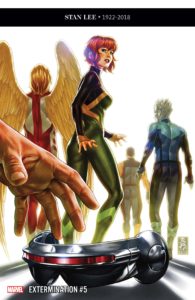 Spider-Man, with the sort-of-reformed Doctor Octopus, and a revamped Spider-Gwen: Ghost Spider — set to launch in 2019: pretty much what we, and Marvel, want out of one of these events. Over in the X-books, Uncanny X-Men continues its 10-issue weekly resurrection arc with an insanely-powerful Nate Grey battling the combined mutants, an intervention from Legion, and a last-page scene shift that should delight ’90s Marvel readers. Extermination is doing its own streamlining and clearing-out of mutant-franchise deadwood, getting the time-lost younger versions of the classic X-Men back where they
Spider-Man, with the sort-of-reformed Doctor Octopus, and a revamped Spider-Gwen: Ghost Spider — set to launch in 2019: pretty much what we, and Marvel, want out of one of these events. Over in the X-books, Uncanny X-Men continues its 10-issue weekly resurrection arc with an insanely-powerful Nate Grey battling the combined mutants, an intervention from Legion, and a last-page scene shift that should delight ’90s Marvel readers. Extermination is doing its own streamlining and clearing-out of mutant-franchise deadwood, getting the time-lost younger versions of the classic X-Men back where they 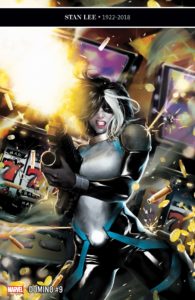 belong, resolving time paradoxes, re-energising Cable, and, on its last page, adding the final missing puzzle piece to complete the X-rebirth: it, too, dovetails neatly enough into Uncanny that, if you’re reading one, you really should be reading the other. Domino is more of a self-contained book, with writer Gail Simone using her patented precise characterization (especially of the good/bad title character), bittersweet sense of humor and you-make-your-own-family themes to make it readable and fun; the encounter with Longshot here, and the clash of two luck-based characters, offers a good display of her talents, especially with David Baldeon’s just-wide-eyed-enough art.
belong, resolving time paradoxes, re-energising Cable, and, on its last page, adding the final missing puzzle piece to complete the X-rebirth: it, too, dovetails neatly enough into Uncanny that, if you’re reading one, you really should be reading the other. Domino is more of a self-contained book, with writer Gail Simone using her patented precise characterization (especially of the good/bad title character), bittersweet sense of humor and you-make-your-own-family themes to make it readable and fun; the encounter with Longshot here, and the clash of two luck-based characters, offers a good display of her talents, especially with David Baldeon’s just-wide-eyed-enough art.
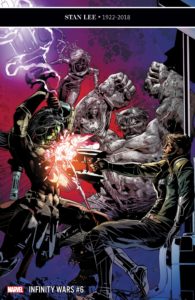 Infinity Wars #6 (of 6) — Writer: Gerry Duggan; Art: Mike Deodato Jr.; Colors: Frank Martin
Infinity Wars #6 (of 6) — Writer: Gerry Duggan; Art: Mike Deodato Jr.; Colors: Frank Martin
Thor #8 — Writer: Jason Aaron; Art/Colors: Mike del Mundo
Marvel Knights #4 (of ) — Story: Donny Cates and Vita Ayala; Script: Vita Ayala; Art: Joshua Cassara; Colors: Matt Milla
West Coast Avengers #6 — Writer: Kelly Thompson; Art:  Daniele di Nicuolo; Colors: Triona Farrell
Daniele di Nicuolo; Colors: Triona Farrell
Runaways #16 — Writer: Rainbow Rowell; Art: Kris Anka; Colors: Matthew Wilson
Infinity Wars ends its run with Loki, Gamora, Warlock and the Guardians of the Galaxy as the main players; one of the Guardians “dies,” although fortunately it’s more subtle, and less cash-grabby, than you might think. There’s an escape clause for all those “Infinity Warped” combined characters, too, just in case Marvel wants to use them again, and as  always the Mike Deodato Jr. art, detailed, muscular and larger than life, is a selling point. Over in Thor, Mike del Mundo’s art is its polar opposite, ethereal and impressionistic; since he’s doing the coloring too, it seamlessly enhances the dreamlike tone. The story itself, involving Thor and sister Angela trapped and tortured in an angels’ prison, is both grimly funny and unusually violent — especially considering it’s Christmas, although of course these Marvel angels aren’t the standard Christian ones. This title’s gearing up for a company-wide ” War of the Realms” event, a couple of years in the making, and this
always the Mike Deodato Jr. art, detailed, muscular and larger than life, is a selling point. Over in Thor, Mike del Mundo’s art is its polar opposite, ethereal and impressionistic; since he’s doing the coloring too, it seamlessly enhances the dreamlike tone. The story itself, involving Thor and sister Angela trapped and tortured in an angels’ prison, is both grimly funny and unusually violent — especially considering it’s Christmas, although of course these Marvel angels aren’t the standard Christian ones. This title’s gearing up for a company-wide ” War of the Realms” event, a couple of years in the making, and this  issue’s a good example of why, under Jason Aaron’s scripting, it’ll probably be good. Marvel Knights continues its high-concept tale of all the heroes having been erased from everyone’s memory; this installment is for Black Panther fans, as T’Challa, now just an anonymous black guy in NYC, gets in trouble with authorities because of his nobility and refusal to accept injustice — and, by the end, recovers his memories and begins to reveal the true conspiracy at the heart of the mystery. West Coast Avengers sees the not-quite-a-team lured to an abandoned amusement park, separated into pairs, and faced with
issue’s a good example of why, under Jason Aaron’s scripting, it’ll probably be good. Marvel Knights continues its high-concept tale of all the heroes having been erased from everyone’s memory; this installment is for Black Panther fans, as T’Challa, now just an anonymous black guy in NYC, gets in trouble with authorities because of his nobility and refusal to accept injustice — and, by the end, recovers his memories and begins to reveal the true conspiracy at the heart of the mystery. West Coast Avengers sees the not-quite-a-team lured to an abandoned amusement park, separated into pairs, and faced with 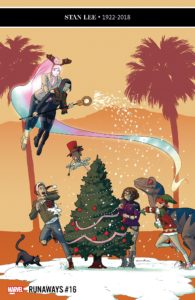 various death traps; it’s a good excuse to focus on the characters and their relationships while showcasing their powers and abilities too (with the Quentin Quire and Gwenpool duo the most interesting). Kelly Thompson is very good at this stuff, and is setting a solid, entertaining foundation for the group. Over in Runaways, Rainbow Rowell is even better at the character stuff; she, Kris Anka and Matthew Wilson have crafted a fun, clever, emotional and really good-looking YA-friendly story that respects the title’s origins and can also be read by anyone who’s seen the TV series: that’s a lot harder than it looks, and they pull it off (click on the cover just to the right there…).
various death traps; it’s a good excuse to focus on the characters and their relationships while showcasing their powers and abilities too (with the Quentin Quire and Gwenpool duo the most interesting). Kelly Thompson is very good at this stuff, and is setting a solid, entertaining foundation for the group. Over in Runaways, Rainbow Rowell is even better at the character stuff; she, Kris Anka and Matthew Wilson have crafted a fun, clever, emotional and really good-looking YA-friendly story that respects the title’s origins and can also be read by anyone who’s seen the TV series: that’s a lot harder than it looks, and they pull it off (click on the cover just to the right there…).
 Freedom Fighters #1 (of 12) — Writer: Robert Venditti; Pencils: Eddy Barrows; Inks: Eber Ferreira; Colors: Adriano Lucas
Freedom Fighters #1 (of 12) — Writer: Robert Venditti; Pencils: Eddy Barrows; Inks: Eber Ferreira; Colors: Adriano Lucas
Aquaman #43 — Writer: Kelly Sue DeConnick; Pencils: Robson Rocha; Inks: Daniel Henriques; Colors: Sunny Gho
Pearl #5 — Writer: Brian Michael Bendis; Art/Colors: Michael Gaydos
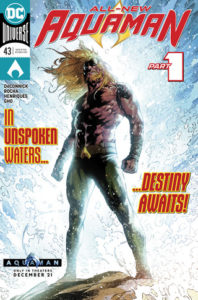 Cover #4 — Writer: Brian Michael Bendis; Art/Colors: David Mack
Cover #4 — Writer: Brian Michael Bendis; Art/Colors: David Mack
Batman #61 — Writer: Tom King; Art: Travis Moore; Colors: Tamra Bonvillain
Batman: Kings of Fear #5 (of 6) — Writer: Scott Peterson; Art: Kelley Jones; Colors: Michelle Madsen
 Catwoman #6 — Writer/Artist: Joelle Jones; Colors: Laura Allred
Catwoman #6 — Writer/Artist: Joelle Jones; Colors: Laura Allred
Freedom Fighters is a new iteration of the ’70s series about a world where the Nazis won WWII (they first appeared in one of those annual JLA “Crisis on…” alternate-universe crossovers with the Justice Society); it’s definitely a reboot, with major original characters having died during the ’40s and their descendants now renewing  the fight in the present. Lots of set-up to establish all of this, of course, but the story’s intriguing enough to buy another issue or two to see what happens, and some pointed commentary about battling facism in America makes it relevant too. Aquaman, hoping to attract the audience for this week’s movie debut, has a very Jason Momoa-esque cover, a new creative team and a new direction, as an amnesiac Sea King is living in what seems to be a small New England fishing village — but, of course, it turns out to be much stranger than that. Kelly Sue DeConnick gets tagged as a feminist writer because of Bitch
the fight in the present. Lots of set-up to establish all of this, of course, but the story’s intriguing enough to buy another issue or two to see what happens, and some pointed commentary about battling facism in America makes it relevant too. Aquaman, hoping to attract the audience for this week’s movie debut, has a very Jason Momoa-esque cover, a new creative team and a new direction, as an amnesiac Sea King is living in what seems to be a small New England fishing village — but, of course, it turns out to be much stranger than that. Kelly Sue DeConnick gets tagged as a feminist writer because of Bitch 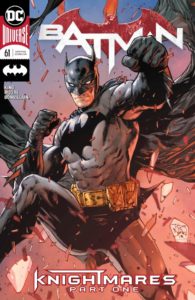 Planet, but her earlier Pretty Deadly showed that she could do mythic, too, and her Captain Marvel that she could do superheroes; it’s those latter two genres that get combined here, and to good effect. Brian Michael Bendis has two new issues of his “Jinxworld” imprint out (the place DC gave him for his creator-owned work), and they’re both distinguished by his obvious delight at writing noirish, high-concept suspense, and by the beautiful art: Michael Gaydos, on Pearl, has the challenge of a main character who’s an extremely skilled tattoo artist (and a newly-hired, if reluctant, assassin), and nails the delicate, intricate ink — while also drawing a
Planet, but her earlier Pretty Deadly showed that she could do mythic, too, and her Captain Marvel that she could do superheroes; it’s those latter two genres that get combined here, and to good effect. Brian Michael Bendis has two new issues of his “Jinxworld” imprint out (the place DC gave him for his creator-owned work), and they’re both distinguished by his obvious delight at writing noirish, high-concept suspense, and by the beautiful art: Michael Gaydos, on Pearl, has the challenge of a main character who’s an extremely skilled tattoo artist (and a newly-hired, if reluctant, assassin), and nails the delicate, intricate ink — while also drawing a 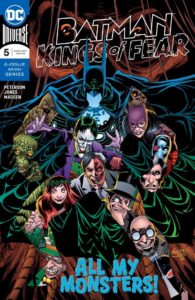 gorgeous double-page splash of San Francisco Bay and the Golden Gate Bridge; over in Cover, about a comic artist who’s been recruited as a not-yet-very-good spy, David Mack gets to use a wide range of styles as he draws various art pages by various artists within the art pages of the main story (he’s paced by old Bendis collaborator Michael Avon Oeming, who does two pages as drawn by yet another character), as well as using his regular bright-water-colored style to illustrate a six-page conversation in a fall landscape that’s worth lingering over. Both of these books are early enough in their runs that you can still get the whole story for cover price, and the combo
gorgeous double-page splash of San Francisco Bay and the Golden Gate Bridge; over in Cover, about a comic artist who’s been recruited as a not-yet-very-good spy, David Mack gets to use a wide range of styles as he draws various art pages by various artists within the art pages of the main story (he’s paced by old Bendis collaborator Michael Avon Oeming, who does two pages as drawn by yet another character), as well as using his regular bright-water-colored style to illustrate a six-page conversation in a fall landscape that’s worth lingering over. Both of these books are early enough in their runs that you can still get the whole story for cover price, and the combo 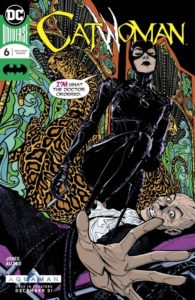 of smart tough-guy storytelling and great art make them worth it. Over in the Caped Crusader corner of the regular DC universe, Batman features the second appearance of a Tom King character who dovetails into the main uber-plot; saying any more than that would be too spoilery, but it’s just as good as always. Batman: Kings of Fear has Kelley Jones drawing the Scarecrow (and some other Arkham denizens), while Catwoman has Joelle Jones on both story and art (as is often true with artists, the script beats are a little disjointed, but man, the art makes up for it); it’s the conclusion of a six-part story, and is almost all action, so it’s as good a display of her many skills as you’ll find.
of smart tough-guy storytelling and great art make them worth it. Over in the Caped Crusader corner of the regular DC universe, Batman features the second appearance of a Tom King character who dovetails into the main uber-plot; saying any more than that would be too spoilery, but it’s just as good as always. Batman: Kings of Fear has Kelley Jones drawing the Scarecrow (and some other Arkham denizens), while Catwoman has Joelle Jones on both story and art (as is often true with artists, the script beats are a little disjointed, but man, the art makes up for it); it’s the conclusion of a six-part story, and is almost all action, so it’s as good a display of her many skills as you’ll find.
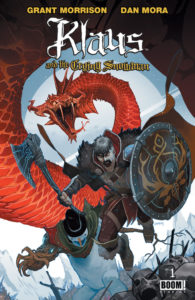 Klaus and the Crying Snowman #1 (of 1) — Writer: Grant Morrison; Art/Colors: Dan Mora
Klaus and the Crying Snowman #1 (of 1) — Writer: Grant Morrison; Art/Colors: Dan Mora
Hardcore #1 — Writer: Andy Diggle; Art: Alessandro Vitti; Colors: Adriano Lucas
Betty and Veronica #1 (of 5) — Writer: Jamie Lee Rotante; Art: Sandra Lanz; Colors: Kelly Fitzpatrick
Klaus is Grant Morrison (and Dan Mora’s) annual Christmas story about a Santa who’s fit, youngish-looking, and battles the forces of darkness; this year, it’s a comet 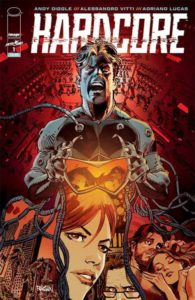 that comes around every 1500 years with evil on its mind… or is it? That’s the hook, and as the title suggests there is, in fact, a crying snowman, in what turns out to be a tale of Christmas redemption and family — with, of course, its share of punching too. Hardcore was one of those Image “Pilot Season” one-shots five or six years ago, created by Mark Sylvestri and Robert Kirkman; its high concept involves an sf, high-tech way of using people as drones — taking over their minds with technology, and using them as assassins. Now, there’s an actual series with the one-shot’s main character, the guy who actually “rides” the victims; he ends up betrayed, and
that comes around every 1500 years with evil on its mind… or is it? That’s the hook, and as the title suggests there is, in fact, a crying snowman, in what turns out to be a tale of Christmas redemption and family — with, of course, its share of punching too. Hardcore was one of those Image “Pilot Season” one-shots five or six years ago, created by Mark Sylvestri and Robert Kirkman; its high concept involves an sf, high-tech way of using people as drones — taking over their minds with technology, and using them as assassins. Now, there’s an actual series with the one-shot’s main character, the guy who actually “rides” the victims; he ends up betrayed, and  has a 72-hour deadline to set things right or he’ll die. Writer Andy Diggle is decent at this kind of slam-bang action-movie milieu, and is able to set up the situation and characters efficiently and clearly; tune in to see if that ticking-clock deadline keeps the energy and the interest up. Betty and Veronica is a new mini-series with those Archie heroines entering their senior year of high school, planning for the future and vowing to remain friends; it’s in the modern-realistic Archie art style, although using the classic pure-hearted versions of the characters instead of the decidedly more grey-area ones on the Riverdale TV version; if you like that setting and those comics, new or old, this should work for you too.
has a 72-hour deadline to set things right or he’ll die. Writer Andy Diggle is decent at this kind of slam-bang action-movie milieu, and is able to set up the situation and characters efficiently and clearly; tune in to see if that ticking-clock deadline keeps the energy and the interest up. Betty and Veronica is a new mini-series with those Archie heroines entering their senior year of high school, planning for the future and vowing to remain friends; it’s in the modern-realistic Archie art style, although using the classic pure-hearted versions of the characters instead of the decidedly more grey-area ones on the Riverdale TV version; if you like that setting and those comics, new or old, this should work for you too.
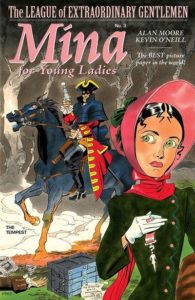 League of Extraordinary Gentlemen: The Tempest #3 (of 6) — Writer: Alan Moore; Art: Kevin O’Neill; Colors: Ben Dimagmaliw
League of Extraordinary Gentlemen: The Tempest #3 (of 6) — Writer: Alan Moore; Art: Kevin O’Neill; Colors: Ben Dimagmaliw
Beasts of Burden: Wise Dogs and Eldritch Men #4 (of 4) — Writer: Evan Dorkin; Art/Colors: Jill Thompson
Middlewest #2 — Writer: Skottie Young; Art: Jorge Corona; Colors: Jean-Francois Beaulieu
Black Badge #5 — Writer: Matt Kindt; Art: Tylar Jenkins; 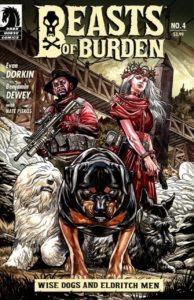 Colors: Hilary Jenkins
Colors: Hilary Jenkins
Firefly #2 — Writer: Greg Pak; Art: Dan McDaid; Colors: Marcelo Costa
A Walk Through Hell #6 — Writer: Garth Ennis; Art: Goran Sudzuka; Colors: Ive Svorcina
Lumberjanes #57 — Writers: Shannon Watters and Kat Leyh; Art: AnneMarie Rogers; Colors: Maarta Laiho
 League of Extraordinary Gentlemen: The Tempest continues Alan Moore and Kevin O’Neill’s final chapters of that long-lived pop-culture/literary mashup; if you’ve been reading it, you’ll get it; if not, this probably isn’t the place to start, although its number of different styles — including a photo-comic section and a color 3D one (with glasses included) — are a flashy reminder of just how complex and rewarding it can be. Beasts of Burden concludes its mini-series about sentient dogs (and other animals) battling occult forces in
League of Extraordinary Gentlemen: The Tempest continues Alan Moore and Kevin O’Neill’s final chapters of that long-lived pop-culture/literary mashup; if you’ve been reading it, you’ll get it; if not, this probably isn’t the place to start, although its number of different styles — including a photo-comic section and a color 3D one (with glasses included) — are a flashy reminder of just how complex and rewarding it can be. Beasts of Burden concludes its mini-series about sentient dogs (and other animals) battling occult forces in 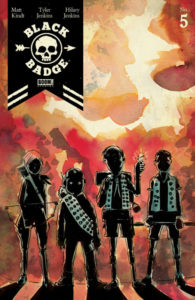 the area around a small town; Evan Dorkin offers a well-crafted plot, with a satisfying payoff, and Benjamin Dewey knows how to draw canines and other creatures that are believable both realistically and anthropomorphically. Middlewest is the second of a new Skottie Young-written series about a young boy in what at first looks like the American Midwest — but, as the slightly-off-kilter title suggests, it’s stranger and more magical than that, with a hero’s
the area around a small town; Evan Dorkin offers a well-crafted plot, with a satisfying payoff, and Benjamin Dewey knows how to draw canines and other creatures that are believable both realistically and anthropomorphically. Middlewest is the second of a new Skottie Young-written series about a young boy in what at first looks like the American Midwest — but, as the slightly-off-kilter title suggests, it’s stranger and more magical than that, with a hero’s 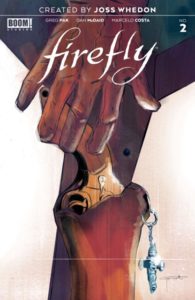 journey/quest/magical companions setup that’s classic and entertaining. Black Badge is another high-conceit book: that there’s a secret, elite top rank of Boy Scouts who work as spies/black ops for the government… or somebody; the conflicting alliances and tradecraft paranoia make it hard to tell. Buy this if you like dense world-building around a suspense/thriller/mystery core — like Matt Kindt’s previous Mind MGMT. Firefly is a continuation of that Joss Whedon-created cult franchise
journey/quest/magical companions setup that’s classic and entertaining. Black Badge is another high-conceit book: that there’s a secret, elite top rank of Boy Scouts who work as spies/black ops for the government… or somebody; the conflicting alliances and tradecraft paranoia make it hard to tell. Buy this if you like dense world-building around a suspense/thriller/mystery core — like Matt Kindt’s previous Mind MGMT. Firefly is a continuation of that Joss Whedon-created cult franchise 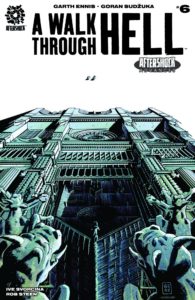 that began as a short-lived TV series, then spawned a couple of comic mini-series, a movie and an enduring seat at the pop-culture table; it’s about Mal and Zoe being hounded as war criminals, and if you’re familiar enough with the characters to know what that means, then you’re the target audience for this book. A Walk Through Hell, about a dead serial killer of children who’s opened a gateway from hell in a mid-city warehouse, and what happens to the two FBI agents who enter it, aims
that began as a short-lived TV series, then spawned a couple of comic mini-series, a movie and an enduring seat at the pop-culture table; it’s about Mal and Zoe being hounded as war criminals, and if you’re familiar enough with the characters to know what that means, then you’re the target audience for this book. A Walk Through Hell, about a dead serial killer of children who’s opened a gateway from hell in a mid-city warehouse, and what happens to the two FBI agents who enter it, aims 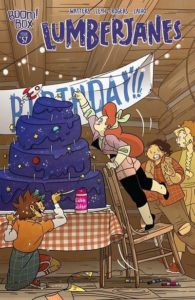 for creeping dread, and usually achieves it; it’s Garth Ennis, after all, and if sometimes there’s more creeping than dread, well, there are always one or two payoff bits to justify it. Lumberjanes starts a new arc about a surprise party for Jo that, to work, requires the hydrophobic Mal to go river rafting; the secret to this book’s success (57 issues!) is that, no matter how cartoony or minimalist the art, the girls’ characters and relationships are clear, consistent, emotionally satisfying and ring true: that gives their adventures higher stakes, and makes readers want to spend time with them.
for creeping dread, and usually achieves it; it’s Garth Ennis, after all, and if sometimes there’s more creeping than dread, well, there are always one or two payoff bits to justify it. Lumberjanes starts a new arc about a surprise party for Jo that, to work, requires the hydrophobic Mal to go river rafting; the secret to this book’s success (57 issues!) is that, no matter how cartoony or minimalist the art, the girls’ characters and relationships are clear, consistent, emotionally satisfying and ring true: that gives their adventures higher stakes, and makes readers want to spend time with them.



